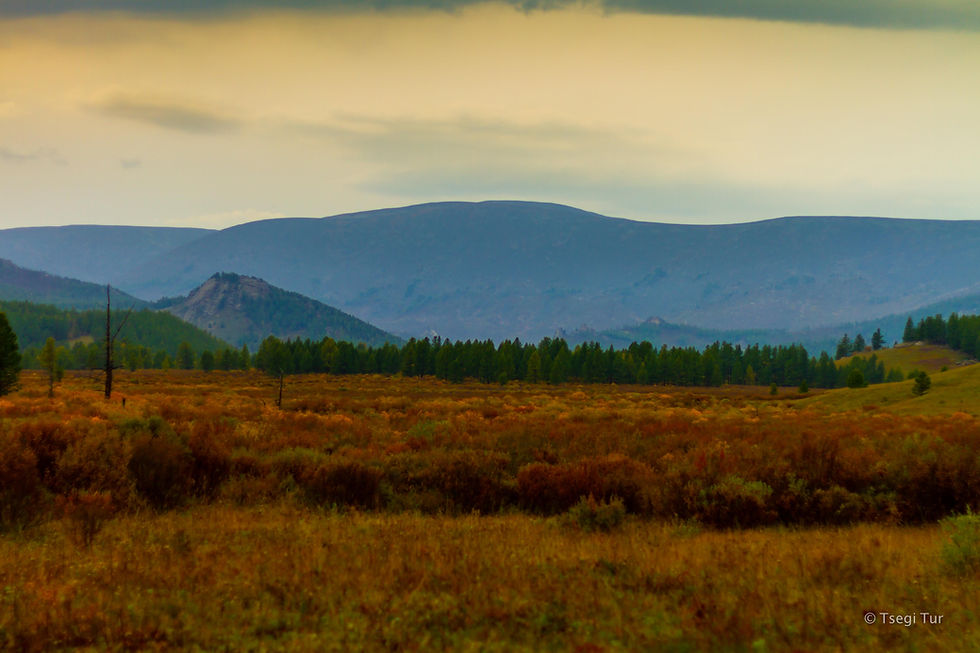
The famous Darkhad Depression also known as Darhadiin hotgor - is one of the most remote places in northwestern Khuvsgul province, Mongolia. It is home to natural habitats classified as Taiga, alpine tundra, glacial formed valleys, forest, and swamp. This region with unique ecological patterns has rich resources of endangered plants and animals not only in Mongolia but also in the world. The valley ecosystem is very diverse with many different coexisting features which is why it is special in that respect. You can easily see the ecosystem's diversity. Darkhad Depression is a large geological depression, and it is roughly the same size as Khuvsgul Lake.
Darkhad valley is situated between the Ulaan Taiga and Khoridol Saridag ranges at an altitude of about 1600 m, about 160 km long, and 40 km wide. The area is 4270 km².
The valley is rich in lakes and rivers, the biggest of which are Dood Tsagaan Lake and Shishged River. The Shishigt River contributes to the Arctic Drainage Basin and runs through the Darkhad Depression, a valley with many lakes. Most of the lakes in Darkhad Valley are 5 to 8 m deep and are similar to each other in terms of water quality, chemical composition, flora-fauna diversity, and biomass. The fish fauna consists of 13 species; among them the world’s biggest Salmonid – the Hucho taimen. Many species of fish live in rivers, lakes, and ponds. Darkhan Lake is the largest reserve of the famous mountain white fish.
Researchers believe that this is the last large white fish reserve in Darkhad Depression.
The lakes are a vital part of Mongolia's very limited commercial fishing industry - white carp and trout. Salmon and huge taimen can also be found in the region.
The Darkhad depression is the confluence of 36 major rivers in Mongolia. In total, it is a watershed with 248 small and large rivers, 377 lakes and ponds, and 24 springs. It makes up 95% of fresh water. From here, the Selenge River flows, and many of its tributaries flow in to Lake Baikal. The largest river is the Delger River. Shishged River is the source of the Yenisei River, which eventually flows into the Arctic Ocean.
The area is noted for its natural environment, but relatively remote and inaccessible even by Mongolian standards.
The rich biodiversity of this land, an important source of valuable genetic resources of plants, animals, and microorganisms, has been safeguarded by the Darkhad for centuries.
The Darkhad depression is home to 70% of the Khuvsgul great Taiga and is home to Mongolia’s largest mammal, elk and reindeer.
American scientists have studied the Darkhad depression and suggested that it should be included in the World Heritage List. The white moss that reindeer feed grows only in the Taiga depression.
People
The Darkhad Valley is divided between the Ulaan-Uul, Renchinlkhümbe, and Tsagaannuur provinces. Inhabitants are mainly Darkhad whom the valley's name derives, and also some Tsaatan, or called Dukha people live there.
Dukha-Reindeer herders are one of Mongolia’s most fascinating and iconic communities, living in teepees with strong shamanic beliefs.
With a population of around 25 thousand people, this nomad Mongol tribe raises their own animal breeds and lives in harmony with nature, according to their customary laws and spiritual beliefs, effectively contributing to sustainable utilization of the biological resources of the region.
The difficulty in reaching the region ensures that the unique Tsaatan people who inhabit the valleys are able to continue their traditional lifestyle - but tourism is slowly making an impact.
They speak the Dukhan language which belongs to the Turkic language family and is close to Tuvan.
Their language is presently highly endangered, only older generations still speak it. Younger generations have switched to Mongolian. The reindeer people live in two separate parts that they call it west and east taiga of Khuvsgul. Both Tsaatan and Darkhad are one of Mongolia's best-known centers of shamanism.
The Darkhad- means Mongolian for "Untouchables", "Protected Ones", or "Workmen of the blacksmith"; are a subgroup of Mongol people living mainly in northern Mongolia, in the Bayanzürkh, Ulaan-Uul, Renchinlkhümbe, Tsagaannuur soum of Khuvsgul province. The Darkhad valley is named after them. The regional variant of the Mongol language is the Darkhad dialect. In the 2000 census, 16,268 people identified themselves as Darkhad.
The Darkhad were originally part of the Oirat or Khotgoid tribes. Between 1549 and 1686, they were subjects of Zasagt Khan Aimag and the Khotgoid Altan Khan. In 1786 they became part of the Jebtsundamba Khutuktu's shabi otog. At roughly the same time they became known as Black Darkhad.
In 1947, 2071 people from 462 households were eligible to be Darkhad. They were liable for maintaining the Great Khan's mausoleum at their own expense before the erection of a permanent government-owned structure in 1954–6. The Darkhad believe they are the direct descendants of the soul guards of Genghis Khan.
Attached video is about the rangers who guard the protected area

Comments